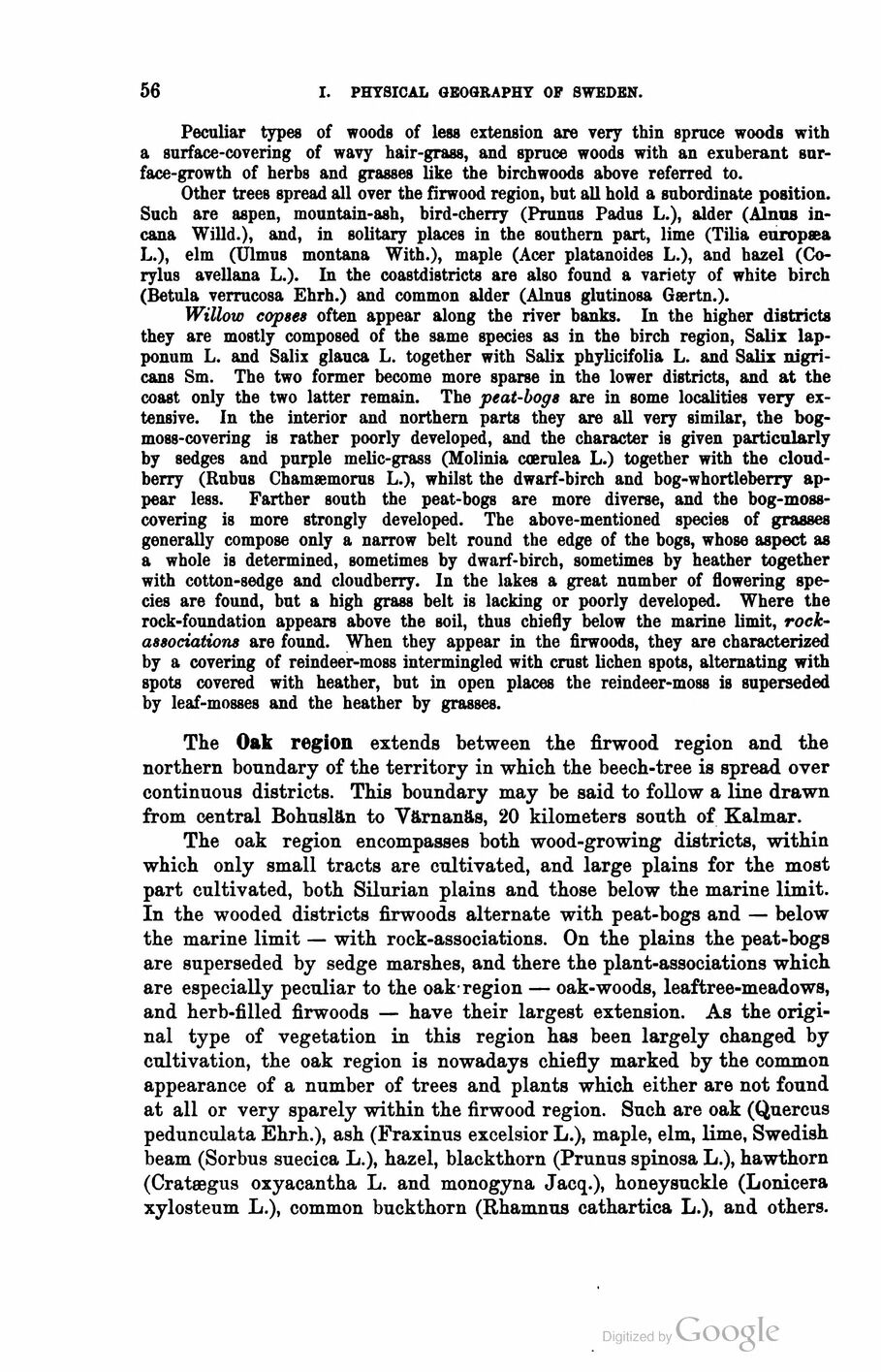
Full resolution (JPEG) - On this page / på denna sida - First part - I. Physical Geography - 4. Vegetation. By Lector A. Nilsson, Ph. D., Institute of Forestry, Stockholm

<< prev. page << föreg. sida << >> nästa sida >> next page >>
Below is the raw OCR text
from the above scanned image.
Do you see an error? Proofread the page now!
Här nedan syns maskintolkade texten från faksimilbilden ovan.
Ser du något fel? Korrekturläs sidan nu!
This page has never been proofread. / Denna sida har aldrig korrekturlästs.
56
I. PHYSICAL GEOGRAPHY OF SWEDEN.
Peculiar types of woods of less extension are very thin spruce woodß with
a surface-covering of wavy hair-grass, and spruce woods with an exuberant
surface-growth of herbs and grasses like the birchwoods above referred to.
Other trees spread all over the firwood region, but all hold a subordinate position.
Such are aspen, mountain-ash, bird-cherry (Prunus Padus L.), alder (Alnus
in-cana Willd.), and, in solitary places in the southern part, lime (Tilia enropæa
L.), elm (Ulmus montana With.), maple (Acer platanoides L.), and hazel
(Co-rylus avellana L.). In the coastdistricts are also found a variety of white birch
(Betula verrucosa Ehrh.) and common alder (Alnus glutinosa Gærtn.).
Willow copses often appear along the river banks. In the higher districts
they are mostly composed of the same species as in the birch region, Salix
lap-ponum L. and Salix glauca L. together with Salix phylicifolia L. and Salix
nigricans Sm. The two former become more sparse in the lower districts, and at the
coast only the two latter remain. The peat-bogs are in some localities very
extensive. In the interior and northern parts they are all very similar, the
bog-moss-covering is rather poorly developed, and the character is given particularly
by sedges and purple melic-grass (Molinia cærulea L.) together with the
cloudberry (Rubu8 Chamæmorus L.), whilst the dwarf-birch and bog-whortleberry
appear less. Farther south the peat-bogs are more diverse, and the
bog-moss-covering is more strongly developed. The above-mentioned species of grasses
generally compose only a narrow belt round the edge of the bogs, whose aspect as
a whole is determined, sometimes by dwarf-birch, sometimes by heather together
with cotton-sedge and cloudberry. In the lakes a great number of flowering
species are found, but a high grass belt is lacking or poorly developed. Where the
rock-foundation appears above the soil, thus chiefly below the marine limit,
rock-associations are found. When they appear in the firwoods, they are characterized
by a covering of reindeer-moss intermingled with crust lichen spots, alternating with
spots covered with heather, but in open places the reindeer-moss is superseded
by leaf-mosses and the heather by grasses.
The Oak region extends between the firwood region and the
northern boundary of the territory in which the beech-tree is spread over
continuous districts. This boundary may be said to follow a line drawn
from central Bohuslän to Värnanäs, 20 kilometers south of Kalmar.
The oak region encompasses both wood-growing districts, within
which only small tracts are cultivated, and large plains for the most
part cultivated, both Silurian plains and those below the marine limit.
In the wooded districts firwoods alternate with peat-bogs and — below
the marine limit — with rock-associations. On the plains the peat-bogs
are superseded by sedge marshes, and there the plant-associations which
are especially peculiar to the oak-region — oak-woods, leaftree-meadows,
and herb-filled firwoods — have their largest extension. As the
original type of vegetation in this region has been largely changed by
cultivation, the oak region is nowadays chiefly marked by the common
appearance of a number of trees and plants which either are not found
at all or very sparely within the firwood region. Such are oak (Quercus
pedunculata Ehrh.), ash (Fraxinus excelsior L.), maple, elm, lime, Swedish
beam (Sorbus suecica L.), hazel, blackthorn (Prunus spinosa L.), hawthorn
(Crataegus oxyacantha L. and monogyna Jacq.), honeysuckle (Lonicera
xylosteum L.), common buckthorn (Rhamnus cathartica L.), and others.
<< prev. page << föreg. sida << >> nästa sida >> next page >>